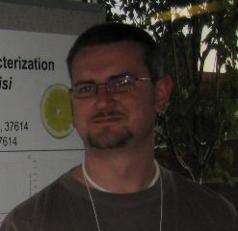

|
Daniel K. Owens Postdoctoral Associate Ph.D. Virginia Tech, Blacksburg, VA; 2005 · Molecular Cellular Biology and Biotechnology Option B.S. ETSU, Johnson City, TN; 1999 · Biochemistry Concentration |
|
Contact Information: ETSU Biological Sciences P.O. Box 70703 Johnson City, TN 37614 Phone: (423) 439-5838 Fax: (423) 439-5958 e-mail: owens1@etsu.edu |
|
Flavonoids are a well known class of plant secondary metabolites that perform a variety of roles essential for plant survival and those beneficial to man as well. Some of these functions also make the compounds attractive targets for biotechnology applications. Flavonoids have long been studied as the major red, blue, and purple pigments in flowers and fruits and are therefore of great interest in the development of ornamental plants (Stafford, 1990). Flavonoid compounds have been shown to contribute to the taste characteristics of fruit, and are therefore of commercial importance in agriculture (Jourdan et al., 1985). Whether the compounds impart a bitter or a sweet taste is directly influenced by the glycosylation pattern of the flavonoid backbone. This is of particular interest in grapefruit where up to 70% of the dry weight of very young fruit consists of flavanone glycosides. Glycosylation is a common modification reaction in plant metabolism and is often associated with the production of secondary metabolites. Glycosylation can serve a number of roles within metabolism including: stabilizing structures, affecting solubility and thereby influencing the ability to be transported in and among cells, and regulating the bioavailability of the compounds for other metabolic processes (reviewed in Vogt and Jones, 2000). The enzymes that lead to glucoside formation are known as glucosyltransferases (GTs), and accomplish this task by transferring UDP-activated sugars to a corresponding acceptor molecule. GTs involved in secondary metabolism share a conserved 42 residue motif (60-80% identity) known as the plant secondary product glycosyltransferase (PSPG) box, which has been demonstrated to encompass the UDP binding moiety. Although the degree of sequence identity within the PSPG box is notable, the overall sequence similarity among identified GTs tends to be fairly low. For example, a set of 99 putative GTs identified from the Arabidopsis genome project had overall sequence identities lower than 30% in many cases (Li et. al., 2000). This lack of overall sequence conservation may be due in part to the fact that the type, extent, and site of glycosylation catalyzed by these enzymes can vary greatly. Purifying and characterizing GTs directly from tissues has led to a wealth of information, but the labile nature of the enzymes has made this approach quite difficult. Establishment of GTs in recombinant expression systems and characterization of the resultant proteins has been shown to be an effective means to overcome this limitation. The recently solved crystal structures for a multifunctional triterpene/flavonoid GT from Medicago truncatula and a flavonol 3-O-GT from Vitis vinifera are tools that will help to begin revealing clues about GT structure/function and mechanistic questions.
References
Stafford HA (1990) Flavonoid Metabolism. CRC Press, Boca Raton Jourdan PS, Mcintosh CA, Mansell RL (1985) Naringin levels in citrus tissues and quantitative distribution of naringin in Citrus paradisi macfad. Plant Phys. 77: 903-908 Vogt T, Jones P (2000) Glycosyltransferases in plant natural product synthesis: characterization of a superfamily.Trends in Plant Science 5: 380- 386 Li Y, Baldauf S, Lim EK, Bowles, D (2001) Phylogenetic Analysis of a UDP-glycosyltransferase Multigene Family of Arabidopsis thaliana. J. Biol. Chem. 276: 4338-4344 |

|
East Tennessee State University Department of Biological Sciences |